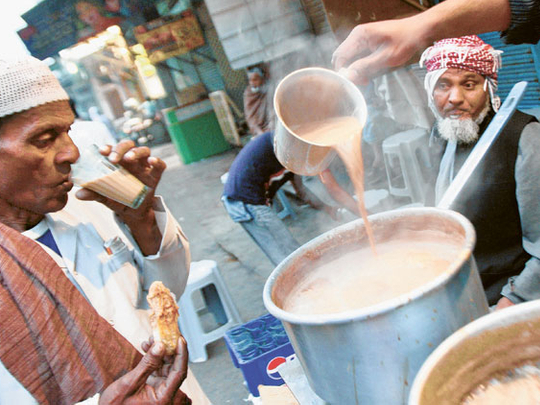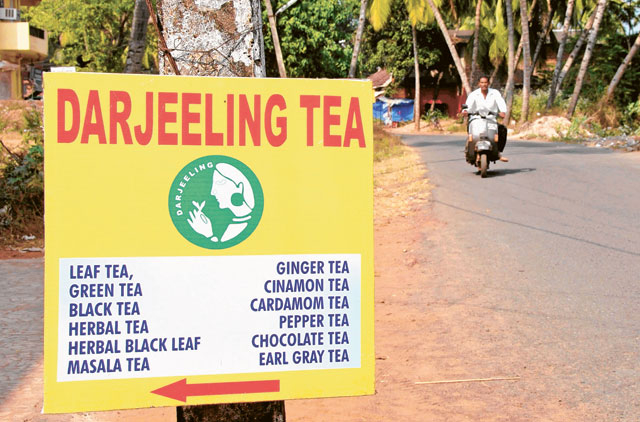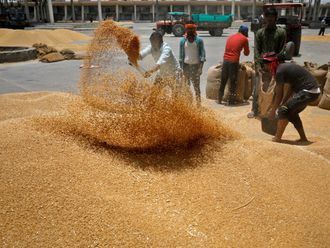
New Delhi: In a country where the ritual of drinking tea is unpretentious and ubiquitous, a great deal of fuss seems to be taking place over it recently.
With the declaration last month by Planning Commission's deputy chairman Montek Singh Ahluwalia that tea is set to attain the status of a national drink by next year, a storm of sorts has hit the Indian teacup.
The humble tea leaf, unlike the tyrannical coffee bean, lends itself to all manners of treatment in India.
On one hand, it is an anaemic, tasteless brew that barely rouses you from your slumber and on the other, it turns into a highly spiced industrial-strength extraction that can kick a mule into behaving like a race horse.
Of course, it assumes various other forms between these extremes as well.
Tea in India is egalitarian in the extreme allowing all kinds of brewing times, additives, spices and seasonings to redefine it. It's also selfless to a fault. Serve it in stained, chipped glasses, cracked mugs, steel tumblers, earthen cups, plastic or Styrofoam holders or in fine porcelain. It won't complain.
In light of the national drink announcement, the Twitterati are brewing up their own commotion.
Hardeep Sidhu, a Sikh, tweeted: "Chai (tea) over lassi from a man hailing from Punjab? Something is not quite right with Ahluwalia's planning!"
Lassi is the traditional yoghurt-based drink of Punjab, among other states.
‘Funny' idea
Novelist Chetan Bhagat tweeted: "Given the never-ending inflation, scams and new taxes, the national drink ought to be not tea, but the common man's blood."
Former Central Bureau of Investigation (CBI) chief Joginder Singh finds the idea "funny".
Singh said: "Ahluwalia has every right to call tea his ‘house drink', but to declare it as a national drink is absurd. I shall stick to my cup of coffee as will other coffee lovers. Who cares?"
Bihar-based entrepreneur A.R.Khan differs. "As lassi to a Punjabi, sattu and Bihari go together. Tea is known as the cup that cheers, but why stir the pot of federalism for no reason."
Sattu is a typical non-yogurt based summer quencher in the state of Bihar.
Meanwhile, Bollywood writer and director Mahesh Nair, a coffee addict, is worried. "What should I do during a film's shooting if someone asks for a chai break? If I ignore and continue to shoot, will that be construed as a national insult?" he wonders.
Ahluwalia announced the decision last month while on a visit to Assam, the tea-producing northeastern state of India. Assam was the home state of pioneering tea-planter Maniram Dewan, who was hanged by British colonial rulers for his role in a plot to oust the British from Assam during India's 1857 mutiny.
The Planning Commission deputy chairman had said that tea would be accorded national drink status by April 17 next year. This would coincide with the 212th birth anniversary of Dewan, who introduced commercial tea production in the region.
Rishad Saam Mehta, a tea and coffee enthusiast, who has researched tea in all its form, goes down memory lane to look at how tea reached India.
"It was introduced to the British in 1661 when Portugal's Catherine of Braganza married King Charles II," he said. "She loved swigging tea, or cha (in Portuguese), which was introduced in Portugal through trade with China. Tea soon caught Charles' fancy. And because the royal couple was slurping tea, the entire populace went gaga over it."
Classy affair
Accorded a ramped up degree of sophistication, high tea became a classy affair, Mehta said.
It always came in a pot which was brought to the table on a tray along with a small milk pot, a sugar pot and a filter or diffuser. Tea cosy, a wraparound cover to keep the pot hot for a longer time, was a must. The cup, saucer and tea pot had to be of the finest porcelain. When served, traditionally, milk was put in first. "Tea connoisseurs in some clubs in India still maintain the old world ritual, where the brew, a delicate infusion, is to be sipped slowly and savoured, not gulped," Mehta said.
The British, with a desire to have their by now favourite beverage close at hand in India, in the 1820s, started cultivating tea on vast tracts of land in Assam. The great Indian love affair with chai was about to begin.
Mehta, author of Hot Tea Across India, a rip-roaring collection of road trip adventures in India linked together by tea, claims that tea cultivation has grown exponentially in India. "But even though our tea is sought after the world over, we end up consuming 70 per cent of what we produce."
It is another matter that the way many Indians consume tea is as varied as it is interesting.
In the most common method, tea leaves are boiled in a pan along with milk and sugar till the concoction attains a thick caramel colour and density, and then strained and sipped piping hot.
Whole lot of spices
Depending on the demand, the region and climate, a whole lot of spices and herbs can also be thrown into the concoction.
"Indians love their spices," Mehta said. "We experimented with a combination of herbs and spices, including cardamom, cinnamon, cloves, pepper and ginger to come up with the now famous masala chai."
The issue of tea has, meanwhile, dragged the other great brew — coffee — into the spotlight.
While tea arrived as an Englishman's breakfast beverage, coffee, Mehta said, "came with Baba Budan Dev, who smuggled a few beans out of Arabia and planted the first coffee near Chickmagalur in Karnataka."
"Coffee has remained a southern favourite. In South India, filter coffee is every household's proud presentation." Both brews were always nodes for conviviality and socialising, but with the advent of the retail revolution in India in the 1990s, coffee and tea stepped up to another level.
From American coffee chains, designer coffee bars, tea houses to tea boutiques, Indian masses are embracing this new dimension with glee and deep pockets.
"Coffee chains and tea houses accentuate the need for socialising. They are yet another place to meet up with friends and shoot the breeze. The coffee [or tea] is an incidental perk," Mehta said.
Exoticism of pursuit
It also helps that a certain exoticism of pursuit is also on offer when you have to choose from strangely exciting names of blends and brews like frapuccino, latte, caramel frappe, etc. It is a long way forward from a homely filter coffee or just your daily chai.
Back to the question of why Ahluwalia chose tea over coffee. A Planning Commission official said: "Ahluwalia is far-sighted. Coffee may be popular, but India is a tea-drinking nation, consuming 840 tonnes annually. This will encourage Indian entrepreneurs to think big while making plans to grab market share. They will, in turn, only end up helping the government."
I caught up with a tea vendor to get his view on the issue. As he skillfully strains the pale gold brew into a glass and offers it to me, Radhe Shyam has a slew of questions.
"Tea as a national drink? You mean, like a national flag? What will it mean?"













